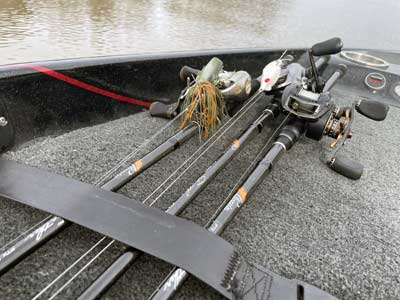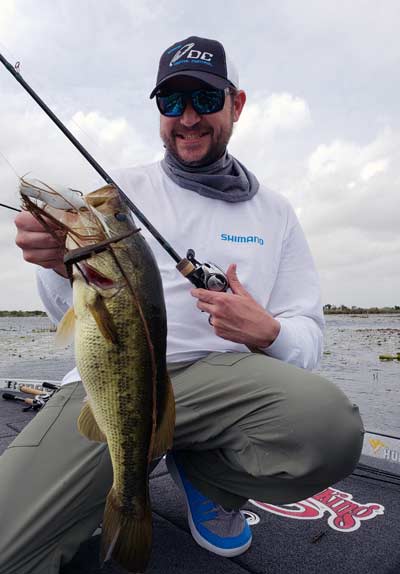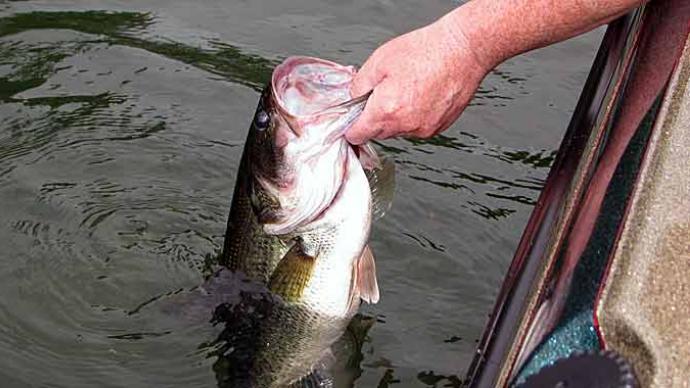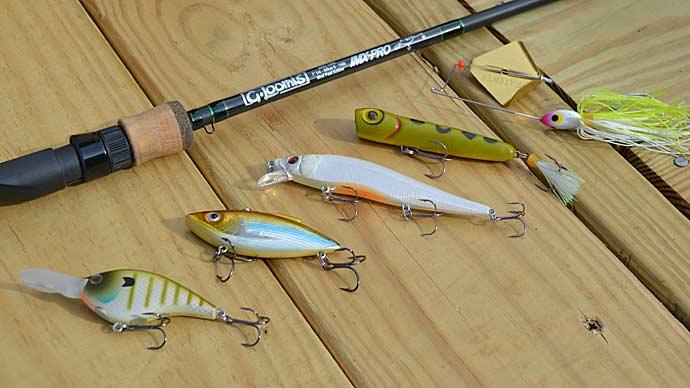
You've likely noticed a dizzying array of choices if you've been shopping for rods and reels lately. Reels come in different sizes and tons of different gear ratios. Fishing rods have been dialed in for specific techniques and even down to single lures and have different handle materials, colors, actions, and more. Having choices is a good thing, but some rods and reels can handle various techniques, and a handful should cover all of your needs.
If you are building your gear lineup, the following five setups will be a great place to start. Then, as anglers discover more techniques and want to have the ability to have more lures rigged and ready to go, it can be time to build on these starting five.
The Spinning Setup
Bass anglers should have at least one spinning rod in their collection, and if you could only pick one, an excellent place to start would be a 7-foot medium. This rod will handle all of your finesse needs, and you can effectively fish a drop-shot, Ned Rig, wacky-rig, Neko Rig, shaky head, and more on this one rod.
For reels, spinning models are all about the same when it comes to casting distance, but as the price level increases, so does the quality. As a result, a better reel will feel smoother during the retrieve, and one of the most significant differences between low and higher-cost spinning reels is the drag system's quality. It can significantly help with landing fish on light line as drag systems are essential for landing hard-fighting fish.
Get the best reel you can afford and select a reel size that balances well with the rod. Depending on the maker, some popular sizes are 2500 or 3000, or 20 and 30. A reel in this size range will hold enough line for the technique and won't be too heavy on the rod.
The Do-It-All Baitcast Setup

If you were to pick just one rod for bass fishing, a 7-foot medium-heavy would be a solid choice. It's perfect for many different techniques and could handle even more in a pinch. The rod size is a good length for long casts and handling fish, and the power of the rod is perfect for popular bass lures and rigs like Texas rigs, jigs, spinnerbaits, buzzbaits, ChatterBaits, and topwaters.
When it comes to reels, the gear ratios available to anglers have gotten faster over the years, and there are now reels with blazing fast speeds of 9.1:1 and 10.1:1. While they are great for picking up line quickly to take up the slack or reel in to make another cast, they aren't needed for every technique, and a reel with a gear ratio of 7.1:1 will be perfect for your needs here.
A Heavier Versatile Combo
Like the 7-foot medium-heavy, a 7-foot heavy rod can do quite a bit. A rod this length, give or take a few inches, can be your tool for fishing jigs, frogs, Texas rigs, and more. It's also stout enough to fish frogs and 4- to 5-inch swimbaits.

Sticking with a reel in the 7.1:1 range will do everything you need with this rod. There are many different reel brands on the market, and all of them will have a gear ratio in this range. When selecting your next reel, consider the cost and the reel's features. Generally, higher-priced reels will be smoother, provide better casting, and last longer than more inexpensive reels.
Cranking Rod and Reel
The crankbait family of lures does require some specialized tackle as the resistance from the baits digging in the water requires a little give in the rod. Crankbait rods are generally limber, and this also helps with treble-hooked baits like crankbaits as it can help to prevent hooks getting ripped out, which can happen with a stouter rod.
A 7-foot medium-action cranking rod would be the one to get if you could only choose one. This rod setup will handle most standard-sized diving, square bill, and lipless crankbaits. However, the jumbo deep diving crankbaits will require a beefier setup to handle the weight of the lure and powerful resistance from these deep divers. While crankbaits are the primary lure for this rod, it could also handle topwaters, ChatterBaits, spinnerbaits, and jerkbaits.
For reels, these baits are one time when a slower gear ratio reel is better as it prevents anglers from moving the bait too quickly. Also, a slower gear ratio will have more power and won't fatigue an angler casting and retrieving all day long. A reel in the 6.1:1 range, or slower, is suitable for these baits.
Heavy Duty Flipping and Pitching
For heavy cover, flippin' sticks are the norm for bass anglers fishing jigs and soft plastics for bass. They allow anglers to use popular presentations like flipping and pitching. Generally, these rods are longer than the others, and a 7-foot, 6-inch size is standard, with some even longer. Having a longer rod helps when making presentations to cover and gives you more leverage when pulling a fish away from the cover.
The rod listed above will be great for jigs and Texas rigs fished around grass, docks, and wood cover. Longer and heavier rods are better suited for heavy weights and jigs over 1-ounce and are needed for heavy-duty techniques like punching grass mats.
For reels, a 7.1:1 gear ratio will be excellent, but some anglers prefer to have a faster reel to reel in their bait and make another presentation quickly. The drawback is that faster reels will have less torque and sometimes lack the power to handle big fish in thick grass or other cover efficiently.
It can be unclear which rod to buy next for bass anglers looking to build their rod arsenal or those just getting started. Thankfully, the five rods and reels listed above can do nearly everything you need to do on the water and offer the perfect place to start.




